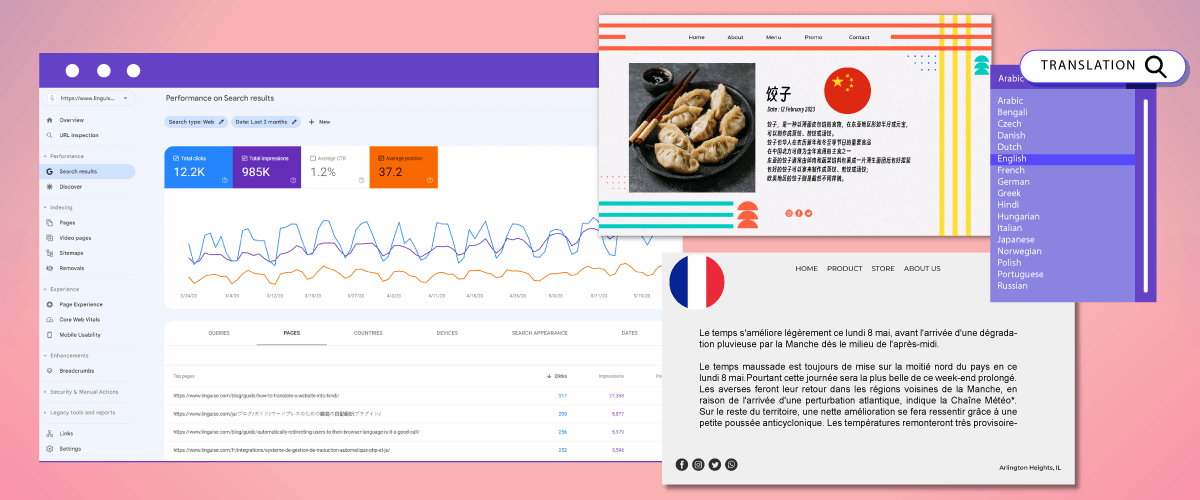Do you want to target the international market and get more visitors from overseas? Web multilingualism can help you achieve this on the condition that you optimize your website for search engines.
When the website is well optimized, the website will appear more often when the audience searches. One way to optimize a website is with Google Search Console. Search Console is Google’s platform to help website owners and developers understand and optimize their website’s performance in Google search results.
So, how do you set up Google the Search Console for a multilingual website? Check out the full explanation below.
Benefits of using Google Search Console for multilingual websites

Before discussing how to setup the Google the Search Console, we will discuss a little about multilingual websites and SEO. For those of you who don’t really understand the importance of Search Console, here are some of the benefits.
- Performance monitoring: Google Search Console provides insight into how your website is performing in Google search results. You can see organic traffic, search position and links pointing to your multilingual site. This helps you monitor performance and see how users find and engage with content in different languages.
- Error notifications: Google Search Console alerts you when there are potential issues that could affect the visibility of your multilingual site. This includes indexation errors, link issues, security warnings, and more. By being aware of these issues, you can quickly address them and ensure that your multilingual site runs properly.
- Sitemap submission: You can submit a custom multilingual sitemap for each language version of your site via Google Search Console. This helps search engines understand the structure of multilingual sites and better index their content.
- Search optimization: Google Search Console provides insight into the keywords and search terms used by users to find your site in different languages. This information allows you to optimize your content and target the most relevant keywords in each language.
Setup the Google Search Console for multilingual websites

Now we will go into several ways to set up Google Search Console for multilingual websites.
There are many Google Search Console parts where you can get and configure interesting international data starting from the data filtering by URL. Just click on the Performance menu , then the right filter button then choose one URL suffix or prefix you have, that’s a good start!
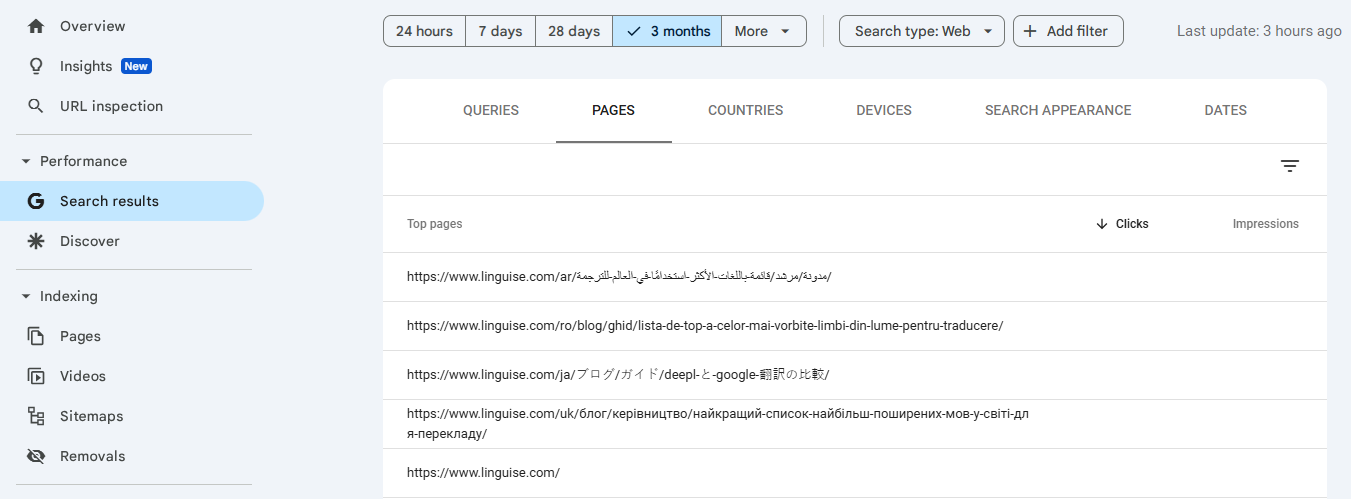
Multilingual sitemaps upload
The first way is to create a multilingual sitemap. A multilingual sitemap is an XML file that contains a list of pages and URLs that exist in a multilingual version of a website. This sitemap is created for websites that offer content in multiple languages. Multilingual sitemaps are created with the aim of helping search engines, such as Google, understand the structure and hierarchy of your multilingual site.
In a multilingual sitemap, each language version of the web page is declared separately using the hreflang attribute. By using hreflang, you can mark relationships between equivalent pages in different languages. For example, if you have an English version and a Spanish version of the same page, you can use the hreflang attribute to indicate the relationship.
Examples of using hreflang are as follows:
<rule name="Linguise language redirection" stopProcessing="true">
<match url="^(af|sq|am|ar|hy|az|eu|be|bn|bs|bg|ca|ceb|ny|zh-cn|zh-tw|co|hr|cs|da|nl|en|eo|et|tl|fi|fr|fy|gl|ka|de|el|gu|ht|ha|haw|iw|hi|hmn|hu|is|ig|id|ga|it|ja|jw|kn|kk|km|ko|ku|ky|lo|la|lv|lt|lb|mk|mg|ms|ml|mt|mi|mr|mn|my|ne|no|ps|fa|pl|pt|pa|ro|ru|sm|gd|sr|st|sn|sd|si|sk|sl|so|es|su|sw|sv|tg|ta|te|th|tr|uk|ur|uz|vi|cy|xh|yi|yo|zu|zz-zz)(?:$|/)(.*)$" />
<action type="Rewrite" url="/wp-content/plugins/linguise/script.php?linguise_language={R:1}&original_url={R:2}" appendQueryString="true" />
</rule>
By using a multilingual sitemap, search engines can understand the structure of a multilingual site and index content according to the target audience. This helps increase the page’s ranking in relevant search results in multiple languages.
Linguise automatic translation plans all include automatic translation of sitemaps.
Here’s how to create and add a multilingual sitemap to Google Search Console.
- Define a multilingual URL structure: define the URL structure that you will use for multilingual pages.
- Create a sitemap for each language version: Create a separate sitemap for each language version. Each sitemap should contain a list of page URLs in the appropriate language.
- Add hreflang tags to each URL: to each page URL in the sitemap, add an hreflang tag to indicate the relevant language version.
- Sitemap verification on Google Search Console: Open Google Search Console and verify your website. After that, add a sitemap for each multilingual language to your Search Console account, as follows. Click Indexing > Sitemaps > Add a new sitemap.
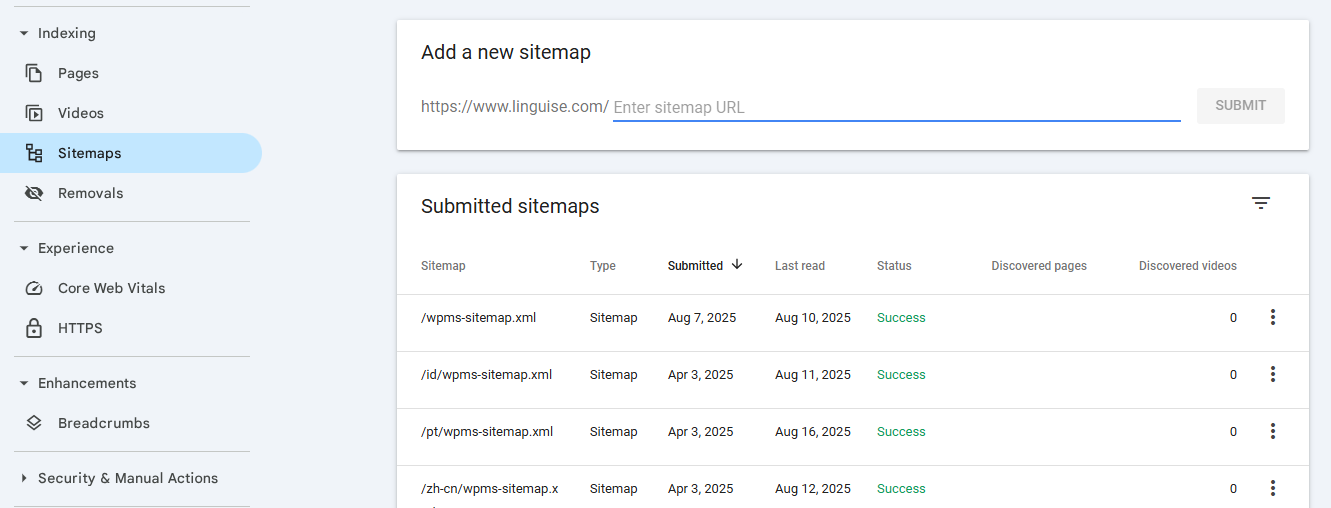
- Update and resubmit sitemap regularly: Whenever you add or remove multilingual pages from your website, update the sitemap and resubmit the sitemap to Google Search Console. This ensures that search engines have the most recent information about your pages.
Check the multilingual pages index
After verifying the multilingual sitemaps, you can then check every page on the website in different languages. To check the page you can use the URL Inspection feature.
This feature allows you to do several things, such as:
- Check index status: to check whether your page has been indexed by Google or not. If the page is not indexed you can fix it immediately.
- Check last indexing: You can see information about when the page was last indexed by Google. This helps you understand how quickly your content updates are indexed by search engines.
- View search results: to preview how your page will appear in Google search results. You can review the appearance of the title, description, and site links to ensure that the information displayed is relevant to the content of your page.
- View URL discovery reports: You can view reports on the number of times your page was discovered by Googlebot and how search engines accessed the page. This information helps you understand how far your site is reachable by Googlebot.
Update video URL by language
Next is updating the video URL based on the language used. If you are using a video on a multilingual website, make sure to update the video URL according to the language used. This helps search engines to display relevant videos according to the language selected by the user.
Use the countries report
The next way is to look at multilingual website performance reports for each country. By looking at reports from each country, you will find out the performance of each content in each language you use.
The countries report in Google Search Console can be accessed by following these steps:
- Go to the Google Search Console website and sign in to your Google account.
- Select the property (website) you want to view the report for.
In the left-hand sidebar, click on the Performance menu, then scroll down and find Search Results, click on the Countries sub-tab.
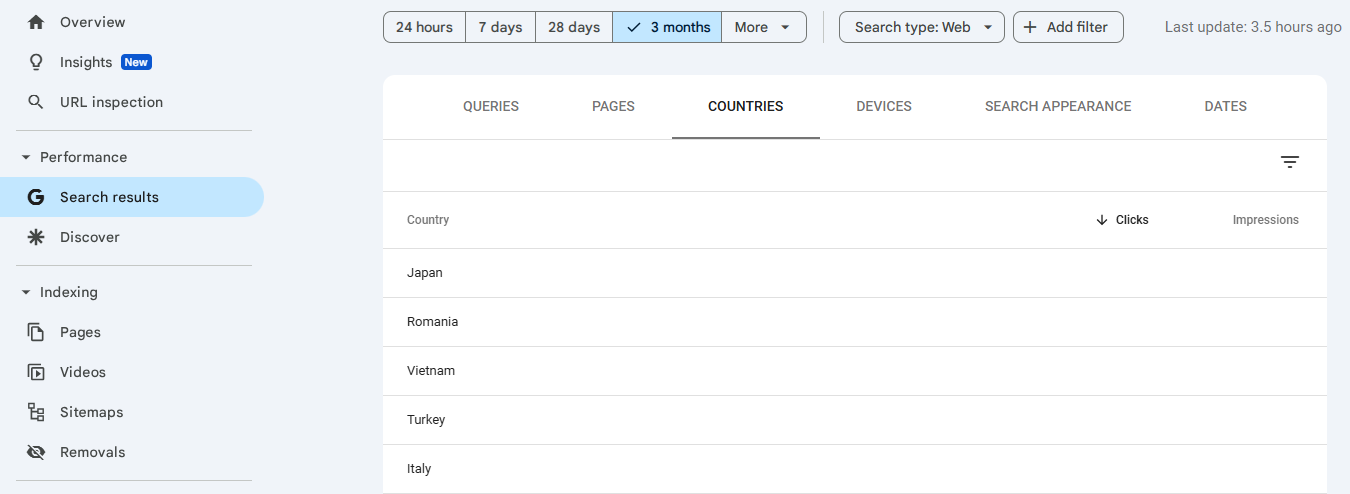
- After that, the report display appears, for example in United States as follows. This page has several report metrics such as total clicks, impressions, CTR, and average position.
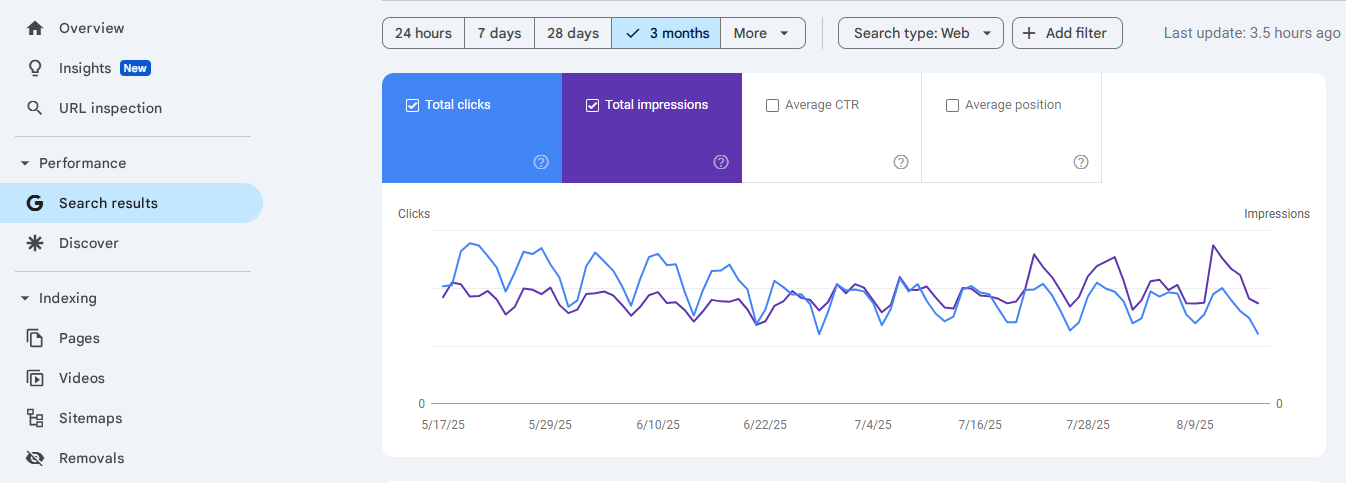
Check the top linked pages in links report
The last way to maximize your multilingual website is to use the Links report in Google Search Console to see which pages on your website are most linked by other sites.
Then check multilingual pages and make sure each language has relevant, high-quality links pointing to the page. After that, if the multilingual page is in a good position, maximize the page so that it stays in that position.
To find the top linked pages in the links report, you can follow the following method. To check the top linked pages, you can follow these steps in Google Search Console:
- Select the desired website property from the dashboard.
- In the left-hand menu, click on Links under the Manual & Security Actions section.
- On the Links page, you will find a section called Top linked pages. This section will display the pages on your website that have the highest number of incoming links from other sites.
- You can click on each page to view more details about the linking website and the anchor text used in those links.
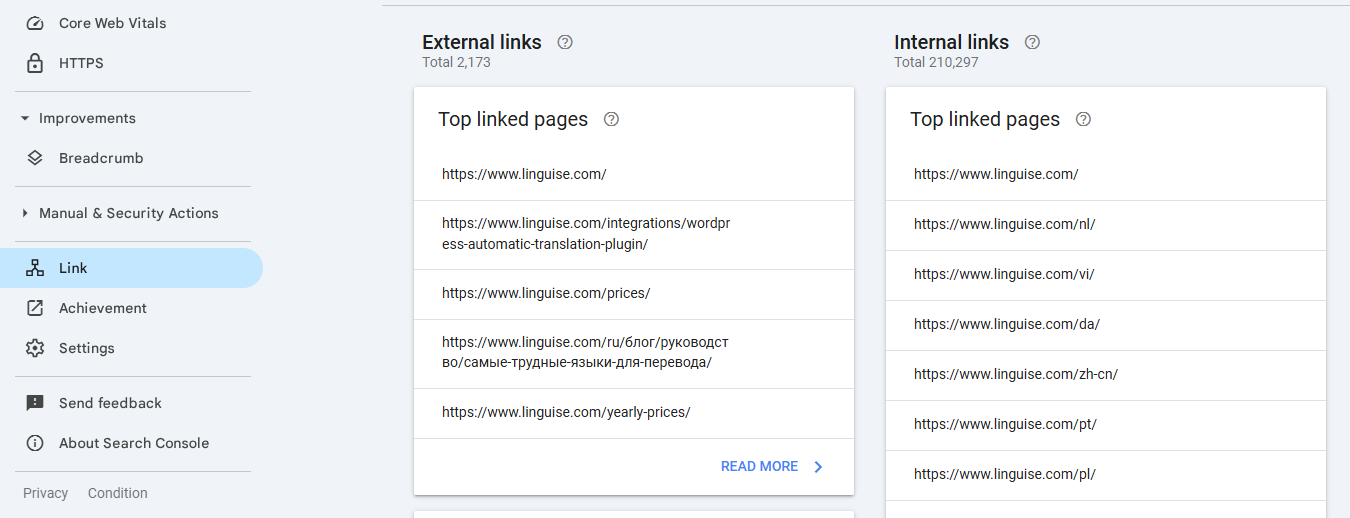
Monitor multilingual content with Insights
Search Console Insights is now directly integrated into the main Google Search Console, allowing site owners to monitor content performance more easily, without needing to be data experts. For multilingual sites, this feature is particularly useful as it displays total clicks, impressions, and engagement for each language version, making it easier for site owners to see which pages are performing well or need improvement.
This feature also helps identify trending pages and queries, whether they are rising or falling, enabling website owners to discover new content ideas and prioritize SEO optimization for each language. In this way, each language version of a multilingual website can be managed more effectively and receive the appropriate attention based on its performance in Google search results.
Here is what the Insight menu looks like in Google Search Console.
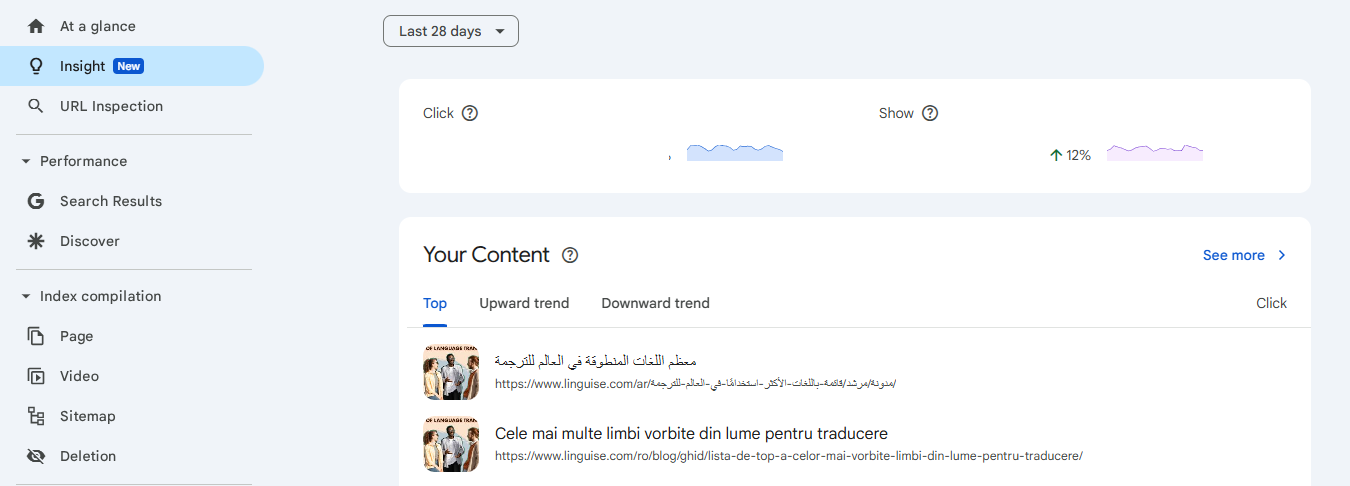
If you select the “See more” menu, more content will appear.
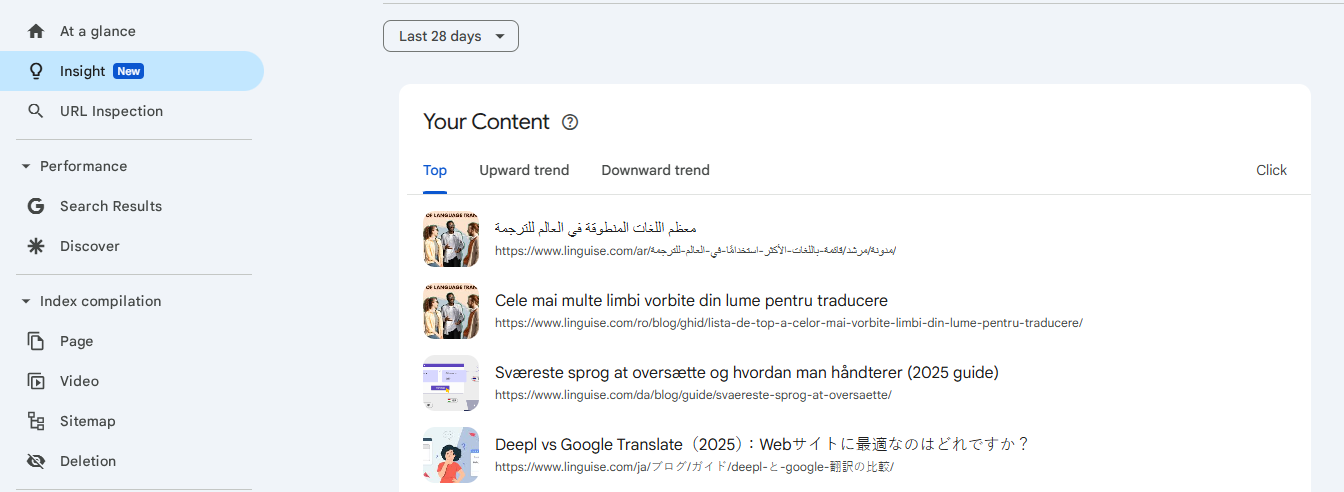
Using recommendations to optimize multilingual pages
The Recommendations feature in Google Search Console provides optimization suggestions based on indexing, crawling, and serving data. For multilingual sites, this is particularly helpful as it highlights specific optimization opportunities for each language version, such as adding structured data to certain pages, updating multilingual sitemaps, or paying attention to trending queries and pages in each language.
With Recommendations, website owners can efficiently prioritize improvement steps, ensure all language versions receive the appropriate attention, and enhance the likelihood of appearing optimally in Google search results. This feature makes managing multilingual websites more focused, especially when there are numerous pages that need to be monitored and optimized simultaneously.
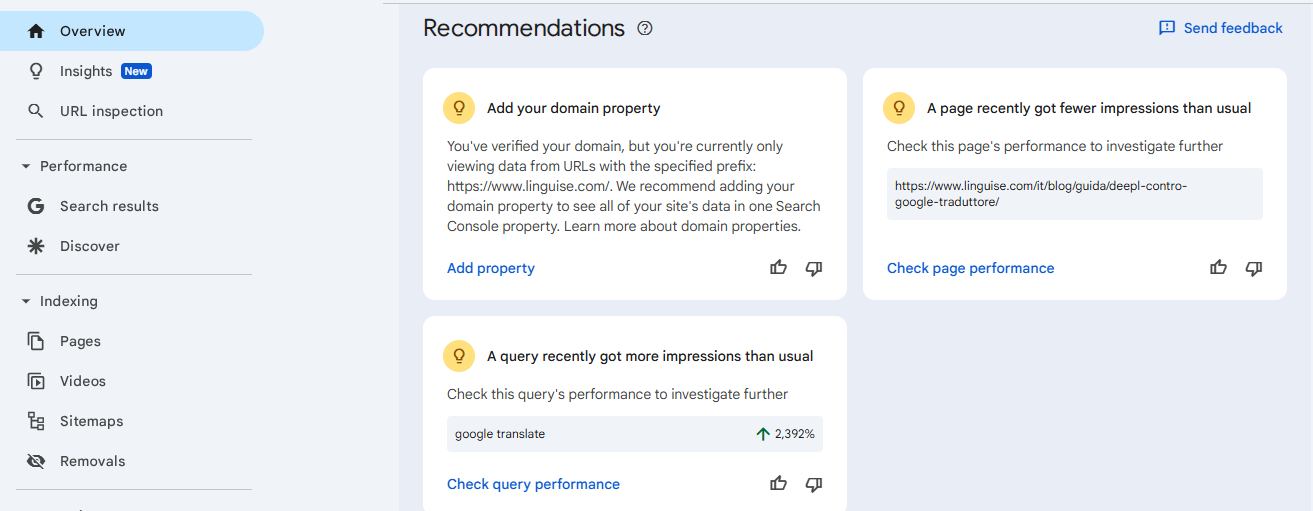
Monitor Core Web Vitals for multilingual pages
After the removal of the Page Experience Report, key metrics such as Core Web Vitals remain available through separate reports in Google Search Console. Core Web Vitals include LCP (Largest Contentful Paint), INP (Interaction to Next Paint), and CLS (Cumulative Layout Shift) for mobile and desktop. For multilingual sites, monitoring these metrics is crucial because each language version may have different structures, content, and visual elements that impact user experience.
By regularly checking Core Web Vitals and HTTPS reports for each language, site owners can ensure that every page delivers an optimal experience. This helps maintain rankings in both local and global search results while minimizing the risk of penalties due to multilingual performance or security issues in each language version.
Troubleshooting FAQ: Common Google Search Console errors with translated pages
Managing a multilingual website can sometimes lead to errors in Google Search Console, especially when dealing with translated pages. This FAQ section highlights the most common issues and provides practical solutions to help you ensure that all language versions of your site perform optimally in search results.

Why are my hreflang tags showing errors?
Hreflang tags are essential for telling Google which language version of a page should appear for specific regions. Errors usually occur when tags are missing, incorrect, or inconsistent across translated pages. Incorrect hreflang implementation can lead to the wrong page being displayed in search results or Google ignoring some language versions entirely.
To fix this, ensure that each translated page includes a correct hreflang tag referencing the proper language and region (e.g., hreflang=”en” for English, hreflang=”fr-ca” for Canadian French). All pages in the same language group should reference each other consistently. For detailed guidance, check our Hreflang Implementation Guide.
What does “Alternate page with proper canonical tag” mean?
This error occurs when Google detects duplicate content across translations and relies on canonical tags to identify the main version. If canonical tags point to the wrong language version, your translated page might be ignored or misclassified in search results.
The solution is to ensure the canonical tag on each translated page points to itself, not to the default language. Verify canonical tags in Search Console Insights or using the URL Inspection tool to make sure every page is recognized correctly.
Why is my translated page “Crawled but not indexed”?
Sometimes Google crawls translated pages but does not index them. This can happen if the translation quality is low, content is duplicated, or the URL structure is unclear. Inconsistent internal linking between language versions can also prevent proper indexing.
Fix this by ensuring translations are high-quality and natural. Use a clear URL structure (e.g., /en/, /fr/) and submit the updated multilingual sitemap to Google Search Console under Indexing > Sitemaps. Regularly review the Recommendations report for any indexing suggestions provided by GSC.
How can I use Search Console Insights for multilingual pages?
Search Console Insights provides a simplified view of how your content is performing across languages. It combines data from Google Search and Google Analytics to show which pages get the most clicks, impressions, and engagement, helping you identify high-performing translated pages.
To use it effectively, log in to Search Console Insights and filter by your multilingual pages. You can compare traffic trends between languages and spot content that needs improvement. Insights can also highlight translation gaps, helping you optimize pages for specific audiences and regions.
Why are some translated pages not showing in the links report?
The Links report shows which pages receive backlinks from other sites. If translated pages are missing, it might be because they have few inbound links, or canonical and hreflang tags are misconfigured, causing Google to consolidate link equity to the default language page.
To fix this, ensure each translated page has correct canonical and hreflang annotations. Promote your localized content to gain backlinks relevant to each language. Regularly check the Links report in GSC to monitor link performance for all language versions.
How do I interpret country performance reports for multilingual sites?
Country reports show how your site performs in different regions, which is especially useful for multilingual websites. You can see clicks, impressions, CTR, and average position for each country, helping you understand which language pages are effective in their target markets.
Access the country report under Performance > Search Results > Countries in GSC. Use this data to adjust content, improve translations, or optimize SEO for specific regions. For example, if your French page performs well in France but not in Canada, you may need to localize content differently for Canadian audiences.
Conclusion
Now, you know how to setup the Google Search Console for multilingual websites. As a multilingual website owner, it is important for you to optimize your website through Google Search Console.
There are several things you can do, starting from multilingual sitemaps, checking pages in multilingual, update video URLs by language, use the countries report, check the top linked pages in the links report.
Apart from using Google Search Console to optimize your website, don’t forget to use the highest quality website translation services.
Linguise is an automated website translation service capable of providing 97% natural, human-like translation results. With a choice of more than 85 languages, you can reach a wider audience and bring in visitors from various countries. If you are interested, use the free trial version for 1 month and translate more than 600 thousand words on your website.

